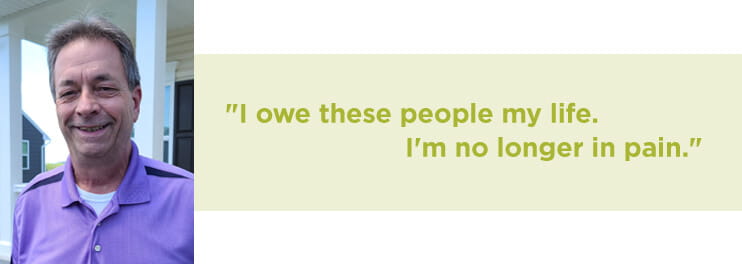Kevin Luster, 62, was doing construction at a friend’s house in April 2020 when he fell and broke his back — for the second time in 20 years. Although he didn’t realize it at the time, it turned out to be his lucky day: the beginning of the end of a decades-long journey with back pain.
A few weeks after the accident, he underwent back surgery at UPMC Montefiore. Within two days, he was up walking — without a walker or a cane — and pain free for the first time in 20 years.
“It was a blessing,” says Kevin. “The best thing that ever happened to me.”
A 20-Year Struggle With Pain
Kevin’s back problems began in 2000 when he fell 32 feet from his roof and broke his back. He was flown by med evac to UPMC Presbyterian where his spine was stabilized with rods and screws.
The surgery saved his life and his mobility — but he always had ongoing back pain. By 2009, the Eighty Four, Pa., resident’s back pain worsened and he started having trouble moving his neck. His doctor at the time suggested back surgery, but Kevin had doubts.
At the urging of his former brother-in-law, a UPMC employee, Kevin consulted physiatrist Gwendolyn Sowa, MD, PhD, chair of the Department of Physical Medicine and Rehabilitation at UPMC and director of the UPMC Rehabilitation Institute. After a thorough examination, she recommended against surgery. Dr. Sowa eventually diagnosed him with diffuse idiopathic skeletal hyperostosis (DISH), a form of arthritis that involves the tendons and ligaments around the spine.
“Going to see Dr. Sowa was the best decision I ever made,” says Kevin. “She has been managing my care ever since.”
Help From a UPMC Quarterback
“Back pain is almost always a journey. It’s a chronic condition, not an intermittent illness,” says Dr. Sowa. She is co-director of the Ferguson Laboratory for Orthopaedic and Spine Research at the University of Pittsburgh and co-principal investigator of Pitt’s Mechanistic Research Center studying low back pain.
Many things can cause pain, including injury, illness, and conditions relating to the muscles, joints, bones, nerves, spine, and other areas, she explains. A physiatrist, or PM&R doctor, focuses on the whole body to identify what’s causing someone pain and help manage and treat the issue.
In Kevin’s case, Dr. Sowa helped guide his care over the years for neck, spine, wrist, knee, and hip pain. She worked with him to determine when he needed therapy, medicine, surgery, or another procedure. She also educated him about the importance of nutrition, fitness, and sleep.
“I’ve served as a quarterback to coordinate Kevin’s care over the years. He has a lot of complexity and a lot of musculoskeletal conditions,” says Dr. Sowa.
“He’s a great example of the importance of interdisciplinary care. Kevin has seen multiple orthopaedic specialists, physical therapists, interventional physiatrists, and even rheumatologists,” says Dr. Sowa. “I help him figure out when it is necessary to change directions in our treatment plan.”
Teamwork in Action
Since 2015, Dr. Sowa has worked closely with Joon Y. Lee, MD, a UPMC orthopaedic spine surgeon and clinical director of the Ferguson Laboratory for Orthopaedic and Spine Research, to address issues with Kevin’s spine.
Upon Dr. Sowa’s referral, Dr. Lee performed a laminectomy and fusion procedure to address nerve compression on Kevin’s spine in 2015. When he later developed kyphosis — an abnormally curved spine — care was focused on posture training and strength-building exercises for his back.
“When there are abnormalities in the imaging, surgery isn’t always the right answer. At the time, there was no clear evidence that a second surgery would improve his symptoms or function, so we partnered with Dr. Lee in nonoperative management,” says Dr. Sowa.
But in spring 2020, in the midst of the pandemic lockdown, Kevin fell and broke his back in the same place he’d broken it 20 years earlier. He called Dr. Sowa, who arranged for the imaging needed to determine his care. The new imaging studies showed that his kyphosis was getting worse, in part due to the abnormal healing of the new fracture. He was developing “clinical flat back syndrome” where his posture was progressively falling forward.
Dr. Sowa and Dr. Lee agreed Kevin needed spinal surgery to address the new injury and related complications. The recommended procedure would involve “re-breaking” his back, then re-aligning the lower back into normal posture and stabilizing it with rods and screws. During the 10-hour procedure, Dr. Lee inserted four rods and 18 screws.
Two days later, Kevin was up walking without a walker or a cane. Two months later, he was back doing construction. He now exercises daily, including 30 minutes on both an elliptical and stationary bike.
“I owe these two people my life,” says Kevin. “I’m no longer in pain. My back is now straight as a popsicle stick and I can touch my toes again.”
“Kevin had a good outcome because we had a coordinated approach to his care. All of his providers worked together to make sure the right thing was done at the right time,” says Dr. Sowa.
Sharing His Perspective
Kevin is now sharing his personal experience with chronic back pain as a member of the Back Pain Consortium (BACPAC) research program funded by the National Institutes of Health (NIH)/National Institute of Arthritis and Musculoskeletal and Skin Diseases (NIAMS). BACPAC is part of the NIH HEAL (Helping to End Addiction Long-Term) initiative. The University of Pittsburgh is one of three sites nationwide selected as an MRC for the patient-centered initiative. It is aimed at improving targeted and personalized treatments for chronic low back pain while reducing the use of opioids.
“By sharing with researchers his experience as a patient, Kevin is helping to make sure research stays relevant and is focused on the things that matter to patients,” says Dr. Sowa.
Kevin’s treatment and results may not be representative of all similar cases.



















